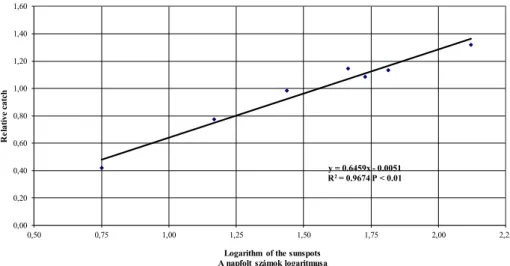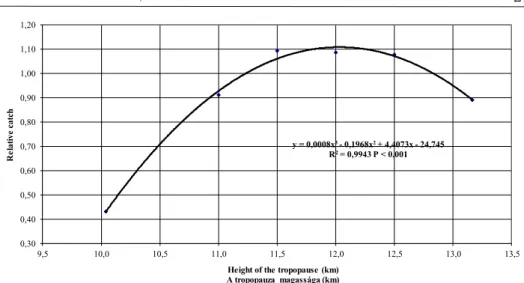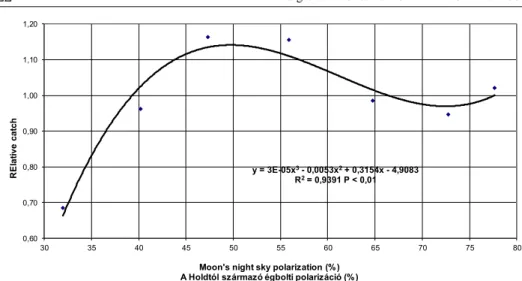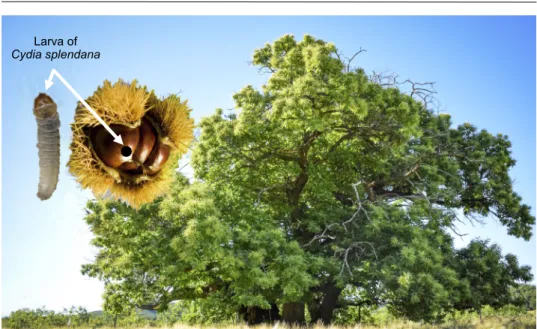The influence of the Sun and the Moon on the light-trap catch of Chestnut Tortrix (Cydia splendana Hübner
[1799]) (Lepidoptera: Tortricidae)
Bürgés György
1,
Kiss Miklós
2, Puskás János
2, Nowinszky László
2& Barta András
3Abstract. The study presents the results of the light-trap catch of the Chestnut Tortrix (Cydia splendana Hübner, 1799) in the context of the sunspot numbers, the height of tropopause and night sky polarization generated by Sun and Moon. The light-trap catches were performed in 1973, in 1974 and in 1977 at the bor- der of Rezi and in 1979 at the near by Zengővárkony. Our results demonstrate that all tree environmental factors significantly affect the flying activity of the examined species, which is evidenced by the change in the number of captured individuals. The catch rises sharply with the higher value of sunspot numbers. When the height of the tropopause and the values of the night sky polarization increase, the catch will also increase to a certain limit but, however, it falls slightly back at their highest values.
Keywords. Light-trap, Chestnut Tortrix, sunspots, tropopause, sky polarization
Author’s address. 1University of Pannon, Georgicon Faculty of Agricultural Sciences | 8360 Keszthely, Deák F. Street 16. | E-mail: burges.gyorgy@gmail.com; 2Eötvös Lorand University, Savaria Campus Savaria Sci-ence Centre | 9700 Szombathely Károlyi Gáspár Square 4. Hungary; 3 Drem Innovation and Consulting Ltd. | 1125 Budapest, Városkúti Street 22/a
A Nap és a Hold befolyása a tölgymakkmoly [gesztenyemoly] (Cydia splendana Hübner [1799]) (Lepidoptera: Tortricidae) fénycsapdás gyűjtésére
Összefoglalás. A tanulmány a tölgymakkmoly [gesztenyemoly](Cydia splendana Hübner, 1799) fénycsap- dás fogásának eredményességét mutatja be a napfolt számok, a tropopauza magasságának, a Nap és a Hold által keltett éjszakai égbolti polarizációval összefüggésben. A fénycsapdás gyűjtéseket 1973-ban, 1974-ben és 1977-ben Rezi, 1979-ben Zengővárkony közvetlen közelében végeztük. Eredményeink azt bizonyítják, hogy mind a három környezeti változó jelentősen befolyásolja a vizsgált faj repülési aktivitását, amit a befo- gott egyedek számának változása bizonyít. A fogás egyértelműen emelkedik a napfolt számok magasabb ér- tékein. A tropopauza magassága és az égbolti polarizáció értékeinek növekedésével párhuzamosan egy hatá- rig emelkedik a fogás, de a legmagasabb értékeknél már kissé visszaesik.
Kulcsszavak. fénycsapda, tölgymakkmoly, napfolt, tropopauza, égbolti polarizáció
Introduction
The chestnut (Cydia splendana Hübner [1799]) belongs to the Palearctic species. It can also be found in Siberia, Japan and Asia Minor. It is widespread in bushy and woodland forests in Hungary. The chestnut occupies deciduous woodland where oak (Quercus) or sweet chestnut (Castanea) occurs. The larvae feed on the internally of the acorn and chestnut. He has a generation every year. The full-fledged caterpillars over- winter in their cocoon. The moths can be seen in July and August from evening to night, and can be attracted by light-traps.
We call solar activity the totality of information, taken place on the surface of the Sun, can be seen on the Earth. The solar activity causes significant changes in the geo- physical parameters of the Earth. Such events may include, for example: a sudden change in the characteristics of weather fronts or the earth's magnetism. These can be followed by changes in biosphere phenomena. Polgár (1966) found that the occurrence e-Acta Naturalia Pannonica 19: 17–24. | 30.04.2019 | HU ISSN 2061–3911
17
© Pannon Intézet | Pannon Institute | Pécs | Hungary
of droughts and inland waters coincides is in the same time when the maximum or minimum of sunspots can be found. Manninger (1975), based on several decades of obser-vations on pest gradations, showed that in the second half of dry periods, there was a gradation between drought-tolerant (xerophil) and dehydrating (hygrophil) species in the second half of inland periods.
The phenomenon of the periodic appearance of sunspots on the hemisphere of the Sun turning to the Earth has been more or less continuously observed since the 17th century. They appear to be dark spots because their temperatures are about 1500 ° C lower than their surroundings. The frequency of sunspots’ appearance is about 11.2 years, but there are change in the number of them, because there are years with a lot of spots, and very few sunspots can be seen in other years. Several measurements are known for the number, intensity, and duration of sunspots. The best-known is the so- called Wolf Relative Number (RW), which is calculated based on observations coming from anywhere in the world and published by the Zurich Observatory. Researchers have been studying the connection between the Wolf's relative numbers and the life- phenomena of various organisms for decades. Martinek (1972) found that the severe damage of the pine-carving wasp (Neodiprion sertifer Geoffroy) occurred every 11 years at sunspots peak. Klimetzek (1976) examined the gradation of several pests be- tween 1810 and 1970. He observed that strong gradations occur during peak and mini- mum of sunspots.
Örményi (1966) developed the FAN numbers (Flare Activity Numbers). Nowinszky and Puskás (2017) discovered a relationship between the FAN numbers and the number of trapped specimens of three butterflies (Ostrinia nubilalis Hübner, Hyphantria cunea Drury and Xestia c-nigrum Linnaeus).
Based on a similar theory, Q-index numbers were developed by two Turkish astrono- mers (Özgüç and Ataç 1989) to characterize the solar activity. This index is also suita- ble for insect testing as described by Nowinszky et al. (2014, 2015) and Puskás et al.
(2010) has already been proven recently.
Neither Wolf's relative numbers nor the Q-index are up-to-date because they are all published with significant delays. In contrast, the solar numbers can be downloaded from the website of the Royal Observatory of Belgium, Brussels. In addition to the in- dexes, the number of sonspots can be successfully applied in entomological research (Nowinszky et al., 2017a, 2018).
Sun activity also affects changes in the Earth's atmosphere. Tropopause is the tran- sition zone between the troposphere and the stratosphere. Its heights usually occur be- tween 8 and 15 km in polar and temperate zones. In summer it can be detected higher than in winter, and it also depends on the latitude. The height at Equator is about 18 km, and only 8 km in the North and South Pole. Low tropopause is associated with the presence of cold air masses, while high tropopause is associated with the presence of subtropical warm air masses. Changes in the height of the tropopause affect the weather of the lower air layers in large areas, so we considered it appropriate to examine the ef- fectiveness of the trapping of chestnut. There are several Hungarian studies in the liter- ature that investigated the effectiveness of light trapping in relation to the height of tropopause (Puskás et al., 2014 and 2018, Nowinszky et al., 2015 and 2017b). So we tested the success of light trapping of chestnut in relation to the height of the tropo- pause.
In the past decades, several studies have been published in the literature that deal with the polarization of the night sky. Berry et al. (2004) has developed a method that accurately describes the polarization pattern of the entire clear sky. Barta et al. (2014) found the degree of polarization of the Sun and the Moon sky.
Recent research has also discovered that insects use the polarization pattern of the
18 Bürgés et al.: Chestnut Tortrix with Sun and Moon
night sky, derived from the Sun and the Moon throughout their night, for their orienta- tion. Dacke et al. (2003) found that Agrotis infusa Boisduv moths use the polarized pat- tern of Sun and Moon for their spatial orientation.
The research and studies of Hungarian researchers on this topic have fundamental importance. We mention only the studies of Suhai and Horváth (2004), Horváth et al.
(1998 and 2002). Hungarian researchers also studied the orientation of aquatic insects in connection with the polarization conditions of the night sky. We can mention the studies of Kriska et al. (2007) and Horváth et al. (2010), which deal with the investiga- tion of aquatic insects in the context of polarization. The book on the relationship bet- ween the night sky and the light trapping insect collection is now available from Nowinszky et al. (2018).
We also found it reasonable to investigate the effectiveness of light trapping of chestnut as well as the degree of polarization of the night sky, similarly to the research of the listed authors.
Material and methods
Jermy-type light traps were in operation in 1973, 1974 and 1977 around Rezi and in 1979 at Zengővárkony. We processed the catch data of the chestnut (Cydia splendana Hübner) from the light-trap material. Traps collected totally 2230 individuals during the 105 nights. However, we could not take into account the data of Zengővárkony in relation numbers of sunspot, because in 1979 the solar activity was much stronger than between 1973 and 1977. In this way, we could work up 1625 individuals with sunspot numbers, which were trapped in 69 nights.
The sunspot numbers, used in our study, were downloaded from the website of Brit- ish Geophysical Survey, Natural Environmental Research Council. Data on the height of the tropopause was collected from the yearbooks of National Meteorological Insti- tute. These data describe a whole day. The data of the polarization of the sky was cal- culated by Barta in the swarming periods of the examined years at 23 hours per night (UT), using the method of Berry et al. (2004).
Relative catch values were calculated from the catch data. This procedure made it possible to process aggregated catch data from different years and villages. The relative catch is the ratio of the number of individuals captured in a given sampling time unit (1 hour or 1 night) and the average number of individuals per generation unit of sampling time. If the number of captured individuals is the same as the average, the value of the relative catch is 1 (Nowinszky, 2003). During each night on which trapping was suc- cessful, we set up environmental variables (solar activity, tropopause and sky polariza- tion) and relative catch data. The data pairs thus obtained were arranged according to the rising values of the environmental variable. All environmental variables and associ- ated relative catch data were classed according to the Sturges method (Odor and Iglói, 1987). The environmental and catch data for each class were plotted and functions were fitted to the resulting curves. The figures show the equation of the functions and the correlation indices.
Results and Discussion
According to our results, the number of captured Chestnut Tortrix increases in parallel with the increase in sunspot numbers. However, this can only be accepted as a fact in the years in which solar activity is moderate, as we have not been able to examine the effectiveness of species collection in other years.
The presence of cool air layers belongs to the low values of tropopause. It is under-
standable, that these values have a low catch. The optimum value is about 12 km from the point of view of the catch when warm air masses are near the ground. In the case of higher levels of tropopause, there is already a very warm flow of subtropical air mass- es, which no longer is favourable for the activity of chestnut and hence on light trap- ping.
As the rising values of the Sun's night-sky polarization the catch also rises up to 50- 55%, and above this values the catch begins to decrease. After this result, we conclude that the flight activity of chestnut is the highest during the night hours. In the evening and at dawn, during the twilight, the polarization of the sky is higher than this value.
The Moon's sky polarization is high at dusk, and low at dawn, but similar to the Sun’s one at night. And if the chestnut flight activity is the highest during the night hours, it is understandable that in both cases, at low and also at high polarization the catch shows low value.
20 Bürgés et al.: Chestnut Tortrix with Sun and Moon
y = 0.6459x - 0.0051 R2= 0.9674 P < 0.01
0,00 0,20 0,40 0,60 0,80 1,00 1,20 1,40 1,60
0,50 0,75 1,00 1,25 1,50 1,75 2,00 2,25
Relative catch
Logarithm of the sunspots A napfolt számok logaritmusa
Fig. 1. Light-trap catch of chestnut (Cydia splendanaHübner) in relation to the logarithm of the sunspots (Rezi) 1. ábra. A gesztenyemoly (Cydia splendanaHübner)fénycsapdás fogása a napfoltszámok logaritmusánaval
összefüggésben (Rezi)
Cydia splendana, adult,
Hungary, Zengővárkony (Grafika: Fazekas I.)
Fig. 1. Light-trap catch of chestnut (Cydia splendana Hübner) depending on the logarithm of the sunspots (Rezi)
1. ábra. A tölgymakkmoly (Cydia splendana Hübner) fénycsapdás fogása a napfoltszámok loga- ritmusának függvényében (Rezi)
y = 0,0008x3- 0,1968x2+ 4,4073x - 24,745 R2= 0,9943 P < 0,001
0,30 0,40 0,50 0,60 0,70 0,80 0,90 1,00 1,10 1,20
9,5 10,0 10,5 11,0 11,5 12,0 12,5 13,0 13,5
Relative catch
Height of the tropopause (km) A tropopauza magassága (km)
Fig. 2. Light-trap catch of chestnut (Cydia splendanaHübner) depending on the height of the tropopause (2 traps) 2. ábra. A gesztenyemoly (Cydia splendanaHübner) fénycsapdás fogása a tropopauza magasságának függvényében
(2 csapda)
Fig. 2. Light-trap catch of chestnut (Cydia splendana Hübner) depending on the height of the tropopause (Rezi and Zengővárkony)
2. ábra. A tölgymakkmoly (Cydia splendana Hübner) fénycsapdás fogása a tropopauza magassá- gának függvényében (Rezi és Zengővárkony)
y = -0,0011x3+ 0,1517x2- 7,0107x + 107,56 R2= 0,967 P < 0,01
0,40 0,50 0,60 0,70 0,80 0,90 1,00 1,10 1,20 1,30 1,40
40 43 45 48 50 53 55 58 60
Relative catch
Sun's night-time polarization (%) A Naptól származó éjszakai polarizáció
Fig. 3. Light-trap catch of chestnut (Cydia splendanaHübner) depending on the Sun's night-time polarization (2 traps) 3. ábra. A gesztenyemoly (Cydia splendanaHübner) fénycsapdás fogása a Naptól származó égbolti polarizáció
függvényében (2 csapda)
Fig. 3. Light-trap catch of chestnut (Cydia splendana Hübner) depending on the Sun's night-time polarization (Rezi and Zengővárkony)
3. ábra. A tölgymakkmoly (Cydia splendana Hübner) fénycsapdás fogása a Naptól származó égbolti polarizáció függvényében (Rezi és Zengővárkony)
22 Bürgés et al.: Chestnut Tortrix with Sun and Moon
y = 3E-05x3- 0,0053x2+ 0,3154x - 4,9083 R2= 0,9391 P < 0,01
0,60 0,70 0,80 0,90 1,00 1,10 1,20
30 35 40 45 50 55 60 65 70 75 80
RElative catch
Moon's night sky polarization (%) A Holdtól származó égbolti polarizáció (%)
Fig. 4. Light-trap catch of chestnut (Cydia splendanaHübner) depending on the Sun's night-time polarization (2 traps) 4. ábra. A gesztenyemoly (Cydia splendanaHübner) fénycsapdás fogása a Hold által keltett égbolti polarizáció
függvényében (2 csapda)
Fig. 4. Light-trap catch of chestnut (Cydia splendana Hübner) depending on the Moon's night- time polarization (Rezi and Zengővárkony)
4. ábra. A tölgymakkmoly (Cydia splendana Hübner) fénycsapdás fogása a Hold által keltett égbolti polarizáció függvényében (Rezi és Zengővárkony)
Fig. 5. Localities Rezi and Zengővárkony in Hungary 5. ábra. Rezi és Zengővárkony földrajzi elhelyezkedése
(Map / térkép © Fazekas I. 2019) Rezi
Zengővárkony
References
Barta A., Farkas A., Száz D., Egri Á., Barta P., Kovács J., Csák B., Jankovics I., Szabó G. &
Horváth G. 2014: “Polarization transition between sunlit and moonlit skies with possible im- plications for animal orientation and Viking navigation: anomalous celestial twilight polari- zation at partial moon”. − Applied Optics 53: 5193−5204.
Berry M. V., Dennis M. R. & Lee R. L. Jr. 2004: “Polarization singularities in the clear sky”. − New Journal of Physics 6: 162.
Dacke M., Nilsson D. E.., Scholtz C. H., Byrne M. & Warrant E. J. 2003: Insect orientation to polarized moonlight. – Nature, 424, 33.
Horváth G., Blahó M., Egri Á., Kriska Gy., Seres I. &, Robertson B. 2010: Reducing the Mala- daptive Attractiveness of Solar Panels to Polarotactic. – Insects Conservation Biology, 24 (6): 1644−1653. DOI: 10.1111/j.1523–1739.2010.01518.x
Horváth G., Barta, A., Gál J., Suhai B. & Haiman O. 2002: Ground-based full-sky imaging po- larimetry of rapidly changing skies and its use for polarimetric cloud detection. – Applied Optics 41: 543−559.
Horváth G., Gál J., Pomozi I. & Wehner R. 1998: Polarization portrait of the Arago point: Video -polarimetric imaging of the neutral points of skylight polarization. – Naturwissenschaften 85: 333−339
Klimetzek D. 1976: Insektenvermehrungen und Sonnenflecken. – Forstwissenschaftliches Cen- tralblatt 95: 226−238.
Kriska Gy., Bernáth B. & Horváth G. 2007: Positive polarotaxis in a mayfly that never leaves the water surface: polarotactic water detection in Palingenia longicauda Ephemeroptera. − Natur- wissenschaften 2007 94:148–154 DOI 10.1007/s00114-006-0180-4
Manninger G. A. 1975: Száraz és nedves évsorok kapcsolata a szántóföldi kártevőkkel. − Növényvédelem 11 (11): 506−507.
Martinek V. 1972: Über die Möglichkeiten der langfristigen Prognose der Massenvermehrung der Roten Kiefernbuschhorn-blattwespe Neodiprion sertifer Geoffr. und die Bedeutung ihre. − Proceeding. 13. International Congress Moskau, 1967, 3: 58−70.
Fig. 6. Castanea sativa in Zengővárkony with larva of Cydia splendana 6. ábra. Szelidgesztenye Cydia splendana hernyóval Zengővárkonyban
(Image and montage: © Fazekas I. 2019) Larva of
Cydia splendana
Nowinszky L., Puskás J. & Kiss M. 2017a: Light-Trap Catch of European Corn-borer Ostrinia nubilalis Hbn. in Connection with the Sunspot Numbers in Hungary between Years 1959- 2006. − Annals of Natural Sciences 34: 60−64
Nowinszky L, Puskás J & Kiss M. 2017b: Light Trapping of Coleoptera, Lepidoptera and Heter- optera Species in Relation to the Altitude of the Tropopause. − Global Journal of Research Review 42: 1−4.
Nowinszky L, Puskás J. Kiss M. & Keszthelyi S. 2018: Light-Trap Catch of Scarce Bordered Straw Helicoverpa armigera Hübner Depending on the Sunspot Numbers between 1993 and 2011. − Word Scientific News 109: 263−266.
Nowinszky L. [ed.] 2003: The Handbook of Light Trapping. – Savaria University Press 276 p.
Nowinszky L., Kiss M. & Puskás J. [eds.] 2018: Light-and Pheromone Trap Catch of Insects in Connection with Gravitational potential of the Sun and Moon and their Night Sky Polariza- tion. – GlobeEdit, Berlin. 118 p.
Nowinszky L., Kiss O. & Puskás J. 2014: Light trapping of the caddisflies Trichoptera in Hunga- ry Central Europe of different catches of the Q-index expressing the different intensities of solar flares. − International Journal of Theoretical & Applied Sciences. 6 2: 23−30.
Nowinszky L. & Puskás J. 2017: Light-trap catch of three moth Lepidoptera species at different values of the “Flare Activity Numbers” – e-Acta Naturalia Pannonica 14: 49–56.
DOI:10.24369/eANP.2017.14.49
Nowinszky L., Puskás J., Mészáros Z. & Kúti, Zs. 2015a: Light-trap catch of moth species of the Becse-type light trap depending on the solar activity featured by Q-index. − Caribbean Jour- nal of Science and Technology 3: 752−760.
Nowinszky L., Puskás J. Kiss O. 2015b: The efficiency of light-trap catches of caddisfly Tri- choptera species in connection with the height of tropopause in Hungary Central Europe. − Molecular Entomology 63: 1−7.
Odor P. & Iglói L. 1987: An Introduction to the Sport’s Biometry. − ÁISH Tudományos Ta- nácsának Kiadása, Budapest. 267 p. (in Hungarian)
Örményi I. 1966: The relationship between geomagnetic activity and chromospheric Ha-flares. − Acta Geodaetica, Geophysica. et Montanistica Acadaemia Scentica Hungarica 1 (1–2): 121–
136.
Özgüҫ A. & Ataҫ T. 1989: Periodic behaviour of solar flare index during solar cycles 20 and 21.
− Solar Physics 73: 357–365.
Polgár Gy. 1966: Connection with the solar activity and inland waters in Hungary. − Vízügyi Közlöny. 1: 130−132.
Puskás J. Nowinszky L. & Kiss M. 2018: Relationship Between Light Trapping of Scarce Bor- dered Straw Helicoverpa armigera Hübner and the Height of the Tropopause. − Noble Inter- national Journal of Scientific Research 21: 1−4.
Puskás J., Nowinszky L., Barczikay G. & Kúti Zs. 2010: The pheromone trap catch of harmful moths in connection with solar activity featured by Q-index. − Applied Ecology and Environ- mental Research 83: 261−266.
Puskás J., Nowinszky L. & Mészáros Z. 2014: Light-trap catch of moth species of the Becse-type light-trap in connection with the height of tropopause. − Nature & Environment, 19 2:
173−178.
Suhai B. & Horváth G. 2004: How well does the Rayleigh model describe the E-vector distribu- tion of skylight in clear and cloudy conditions? A full-sky polarimetric study. − Journal of the Optical Society of America A 21: 1669−1676.
24 Bürgés et al.: Chestnut Tortrix with Sun and Moon



